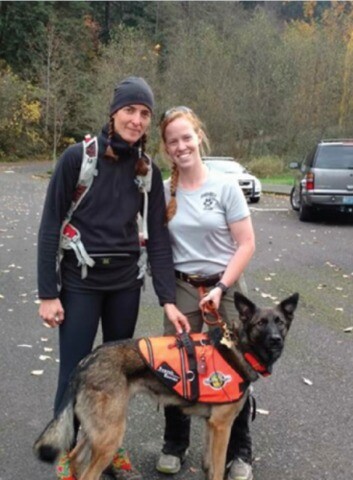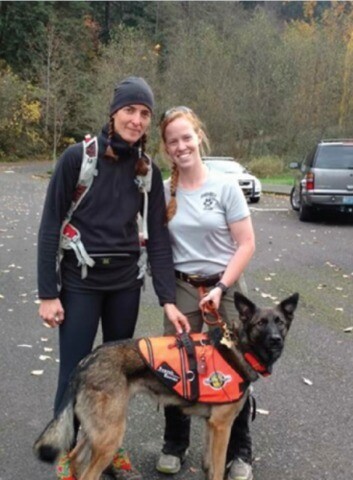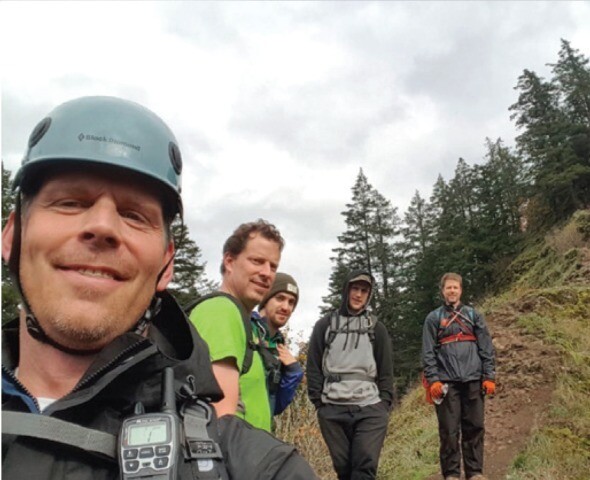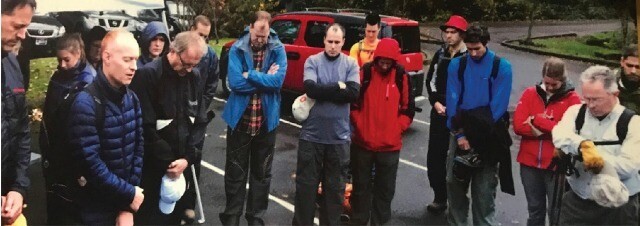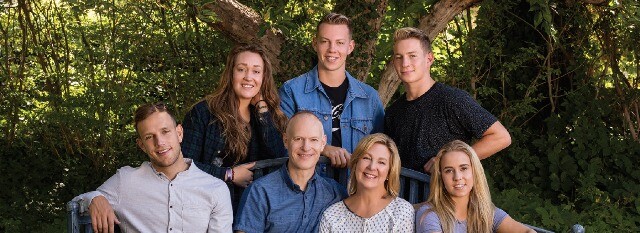Driving through the rain-soaked streets of Portland, Oregon, on October 19, 2016, Michelle Schmidt wasn’t worried about her oldest daughter, Annie Schmidt, even though Annie hadn’t arrived to pick Michelle up from the airport.
This week was supposed to be their great mother-daughter adventure, beginning with camping in the Portland area. But when Michelle called Annie as she exited her gate at the airport, Annie didn’t answer her phone.
“I was curious about why she wasn’t there, but I wasn’t worried at the time,” Michelle remembers. “I just thought, ‘Okay, I’ll go rent a car and find out where she is.’”
But as she navigated the unfamiliar roads of Portland, a sense of unease slowly began to form in the back of Michelle’s mind.
Parking the car, Michelle made her way up to her daughter’s apartment and knocked on the door.
“Is Annie here?” Michelle asked her daughter’s roommate, who opened the door.
After a moment of uncomfortable silence, Annie’s roommate blurted out six words that would bring horror into Michelle’s life for the ensuing weeks: “I thought she was with you.”

Annie Schmidt, photo by Tessa Barton
Annie Is Missing
Michelle was imagining the worst. Her daughter was missing. No one had seen or heard from her since Sunday. It was now Wednesday. Michelle’s usual level-headedness disappeared as she sat in Annie’s apartment and listened to her daughter’s roommate explain that all this time she thought Annie had left on the trip with Michelle early.
Was Annie kidnapped? Was she hurt? Was she lost? An endless cycle of nightmarish scenarios played through Michelle’s mind as she sat alone in a police station at 9 p.m. As she waited for an officer to help her, the only comfort was the voice of her husband, Jon Schmidt, coming from the other end of the cell phone.
When an officer did approach Michelle, however, she was bombarded with questions: “Was Annie on drugs?” “Was she suicidal?” and “Have you argued with her lately?” They were routine inquiries, but Michelle’s anxiety spiked with each and every question mark.
“Ask the officer if it’s okay to say a prayer with him,” Jon suggested from the other end of the line. The officer agreed to the prayer, though Michelle thought he looked a little uncomfortable.
As she prayed, Michelle sobbed for the first time since discovering Annie was missing. After the “amen,” the officer seemed a little kinder, and he informed Michelle that they would call her when an officer was assigned to the case.
Later that night, Michelle received the call, but it became apparent that things would not move as quickly as she had hoped. During the three-way call between Michelle, the officer, and Jon, she learned that because Annie was an adult, it could take days to legally ping her phone to find her location. Michelle knew that if Annie was stranded and hurt somewhere, those few days could mean the difference between life and death. But all she could do was wait out the night.
In the morning, Jon arrived in Oregon with their oldest son, Spencer. Some progress was made when officers found Annie’s car off the highway near the Columbia River Gorge National Forest, a popular location for avid hikers like Annie. After receiving permission from Annie’s cell phone carrier, the police were also able to ping her phone much sooner than anticipated.
But the progress wasn’t what it seemed. The ping, which was supposed to lead searchers to Annie’s phone and potential location, only led to her already-discovered car. Her phone was nowhere to be found, and neither was Annie.
Though search and rescue workers were doing all they could, the official search wouldn’t begin until Friday—five days after Annie went missing.
“Okay, I’ll Go”
“Turn on the TV.”
The thought caught Lydia McGranahan off guard as she sat typing in her home.
“It was like my own voice, but it wasn’t my own voice because it’s not something I would say to myself,” McGranahan remembers. “I don’t watch a lot of TV. I’ve never watched a lot of TV.”
But the thought came again: “Turn on the TV. Turn on the news.”
Finally, unable to ignore the strange thought, McGranahan flipped on the television and caught the end of a news blurb about a missing woman in the Portland area. She resumed her writing until the story was repeated.
“I jumped up and went running in there because I felt like that was what I needed to hear,” McGranahan remembers.
This time, she heard the story of the missing 21-year-old hiker named Annie.
As she listened, McGranahan pulled up a map of the area on her computer. While she had never hiked where the woman’s car was found, she was familiar with the rugged, sometimes treacherous terrain of that gorge.
As the news story ended, McGranahan had another distinct and powerful impression: “You need to go look for her.”
At first, she balked at the thought.
“I’m not a search and rescue person,” she says. “Why would I go look for her? I’m not even qualified.”
But throughout the day, the thought kept haunting her. Later that evening, McGranahan decided to at least look up the missing woman. That’s when she learned that Annie was the daughter of one of the Piano Guys, whose music she had been listening to before she turned on the news.
“So here I am, being asked to go look for this missing hiker. I had no idea who she was,” she shares. “It comes up that she’s the daughter of Jon Schmidt, and at that point, I was like, ‘No way.’ Because here I am, at my computer desk, listening to the Piano Guys on Pandora, being told to go turn the TV on. At that point I’m going, ‘God, what are you up to right now?’”
Soon McGranahan came across a Facebook post from Michelle asking for help from anyone experienced with off-trail hiking.
“I just felt like something said, ‘You need to go.’ I really surrendered in that moment and said, ‘Okay, I’ll go.’”
“I Knew You Would Love It”
Driving alone to the search and rescue base camp, Michelle finally saw the emerald greens and brilliant blues of the Columbia River Gorge Annie had told her about.
“I just said out loud, ‘Annie, I think this is so beautiful!’”
Michelle remembers. But she wasn’t expecting what came next. “[Annie] said to me, ‘I know, Mom. Isn’t it so beautiful? I knew you would love it.’”
In that moment, all the questions and the endless cycle of nightmarish scenarios melted away.
“It was so comforting,” Michelle remembers, “because I’m like, ‘Okay, you’re not suffering on the mountain. You’re in the spirit world.’”
When Michelle reached base camp, things were not as she had expected. She had been told there would be multiple search dogs looking for Annie. Michelle saw only one. And though she and Jon had been told there would be as many as 100 search and rescue volunteers, there were not nearly that number. That’s when they learned that another hiker was also missing in the gorge, spreading search and rescue teams thin.
Despite being advised otherwise because of the dangers of off-trail hiking, Jon and Michelle knew it was time to reach out to their family and friends through Facebook and ask for experienced hikers to help with the search.
That message would be the key to finding their daughter.
A Dream of Annie
McGranahan arrived at the base camp to find that she wasn’t the only one who had seen Jon and Michelle’s Facebook post. Hundreds of people had gathered for the search, and unlike McGranahan, most of them were members of the surrounding LDS wards and stakes.
Though she didn’t feel experienced in search and rescue, McGranahan was an experienced hiker. After searching for hours to no avail and with no more organized searches for the day, McGranahan headed to where Annie’s car had been found.
She remembers, “I went and stood where her car would have been parked and I just said, ‘God, where did she go? Where did she go from here? Lead me.’ And I started walking.”
Hiking through waist-high ferns, over moss-covered boulders, and around trees that grew leaves as big as her head, McGranahan eventually reached the top of Munra Point. Looking down from the slim peak, McGranahan could see why someone would brave the off-trail hike: the view was magnificent and overlooked much of the lush river gorge.
“As I was up there, I really felt strongly in my spirit that [Annie was] going to be found somewhere on Munra,” she remembers.
But McGranahan didn’t have much time to look around that day. It was getting late, and by the time she made it back to base camp, almost everyone had left for the evening. That night, however, she had a dream.
“In the dream, I was falling [from a cliff], and as I’m falling, I’m seeing Annie’s face. But I’m feeling my body falling. In my dream I remember questioning, ‘Well, is it Annie, or is it me who’s falling?’ . . . But before either of us even hit the ground, I woke up.” She woke to the name “Munra” resounding in her mind and on her lips.
Without a doubt, McGranahan knew where to find Annie.

Munra Point Mountain looking from the Columbia River, photo courtesy John Harding
One Search Ends, Another Begins
Three days. That was the longest the thinly stretched search and rescue teams could afford to scour the gorge for Annie. It wasn’t much. But the Schmidts poured out all of the effort their faith, desperation, and physical stamina could muster.
For the first two days of the official search, Jon and Spencer hiked for hours on end. But unlike Michelle, Jon was still clinging to the hope that they would find their daughter alive.
“He would yell and yell and yell,” Michelle shares, remembering Jon’s efforts to find Annie. “And he would do this musical triad because he knew that that was something she would identify with.”
But even after countless prayers and hours of experienced hikers and search and rescue teams alike pouring their energy into finding Annie, there was still no trace of her.
“It felt like we were taking the ultimate, faithful approach,” Jon remembers. “So it just made it so much more disturbing to get nothing.”
Despite being tried to their very limits, Michelle shares, “We hadn’t found Annie, but we know that God is real and we know that He’s heard our prayers in the past. We don’t know why He wasn’t showing us where she was, but we were not going to lose our faith.”
Clinging to that faith, the Schmidts were faced with a choice. They couldn’t stay in Oregon forever, especially with their youngest daughter, Sarah, waiting for them alone in Utah.
It was then that Franklin Covey executive and family friend John Harding stepped up.
"I’ll remember forever the feeling of that Sunday night watching the sheriff pack up and drive away without finding Annie, leaving the Schmidt family and a few friends in a dark rainy parking lot in the gorge, 630 miles from home," Harding shares. "I was shocked they were done, but I remember how grateful the Schmidts were for the limited search efforts."
Standing in that darkened parking lot with a hand full of friends and family of the Schmidts, Harding was approached by Spencer. "Spencer came over to me and said his dad would like to talk with me," Harding remembers.
“Jon said, ‘Hey, we’re not sure what to do.' And I said, ‘You know what to do. We’re never going to give up. You’re going to look until you find her. We’re going to find her.” At that, Jon and Spencer asked Harding to take the reins as search leader.
This was another miracle, because only a few days earlier Harding had been in a hotel at Bryce Canyon in Utah enjoying a relaxing vacation with his family. On Thursday night, John received a text from one of his daughters—a friend of Annie’s—about Annie’s disappearance.
“I really couldn’t sleep,” Harding remembers. By 6 a.m., his bag was packed, and by Friday, October 21, he was in Oregon, just two days after Annie was reported missing. Now here he was, facing what many might have felt was an overwhelming task.
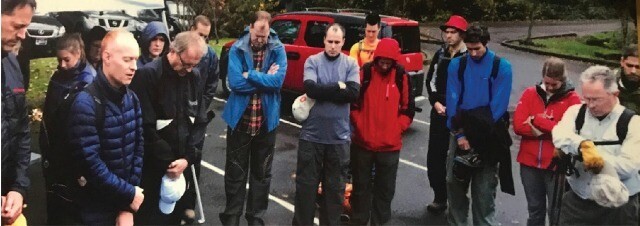
Jon Schmidt and volunteer searchers offer a prayer, photo courtesy of the Schmidt family
“I just felt energy,” Harding says. “I was thinking [about] where and who and what we needed to do. I totally believed we would find Annie every day we searched.”
“He was so full of faith,” Jon remembers. “He took this crushing burden from our shoulders and organized everything that needed to be organized.”
But there was still one more key person needed in the search to find Annie.
Visions of Annie
About two weeks after Annie Schmidt went missing, the walls of Annie Castiel’s Idaho home looked like they belonged in a mission control station. When Castiel heard about the missing 21-year-old Mormon girl, she felt an instant connection.
“I thought, ‘Wow, she’s a lot like who I was at that age,’” Castiel remembers. “She was just fearless and taking a lot of chances and loving the outdoors. I was a lot like that.”
Unable to join the search efforts in person, Castiel organized a private Facebook page that allowed volunteer searchers to communicate, coordinated with the forest service, and encouraged the use of GPS mapping systems that could track areas already searched. When Michelle personally called Castiel and asked for advice, Castiel not only advised bringing in trained search dogs but she promised to find them.
Because of her 13 years of experience on search and rescue teams, Castiel knew that search and rescue dogs could cover more ground faster and more effectively than human searchers. But she still felt terrified. What if she couldn’t deliver on her promise to get search and rescue dogs and their handlers to Oregon?
Then, at one point while she was outside on her back porch, a thought came screaming through her mind. “It was like someone saying, ‘Mortenson, Mortenson, Mortenson!’” Castiel remembers. “At the same time, I had this strange, overwhelming vision of a ridgeline with snags sticking out up above it. It was a profound vision that was really specific. I had never had this happen to me before, ever.”
Perplexed, Castiel went inside and looked up the name “Mortenson.” She found a Mortenson mining company from California that had explored for mines in the area Annie went missing. While clicking through pictures, Castiel found an exact image of what she had seen in her vision. The last name of the person who took the photograph? Mortenson.
“This all happened in 30 seconds,” Castiel remembers. “My heart was in my throat, and I thought, ‘What on earth is going on?’”
On the other hand, every rescue dog handler she had called in Utah, Wyoming, Idaho, and Colorado had turned her down. Castiel realized that she could very well be forced to break her promise to the Schmidts.
“That night I was trying to figure out how I was going to call the Schmidts and tell them this,” Castiel says, “and I got this vision of Annie lying below a cliff in a scree area. . . . I pictured her lying in this area with the littlest opening, and she was looking up at the sky.”
After these two miraculous experiences, Castiel knew she couldn’t give up. And with extra encouragement from Harding, Castiel kept searching and finally contacted the very last person on a rare list of options.
“I was kind of frantic at that point,” Castiel remembers. But by the end of the call, the search and rescue handler and Yellowstone park ranger agreed to join the search with seven other handlers and their dogs. Within days, all of the dogs and their handlers were on planes to Oregon for what would be the final search for Annie.
Angels at Home
Though Michelle, Jon, and Spencer eventually returned to Utah, they were still a very active part of the search. Michelle woke up each day hopeful that someone would find her daughter, but the crushing grief of losing a child enveloped her like a fog. Even when she was experiencing such pain and trauma, though, she also felt the love others had for her family.
“The people who helped us were just epic,” Jon shares. “Heavenly Father sent angels, human angels. . . . It was like they carried light and comfort.” Michelle adds, “I’m just blown away at how kind people were.”
In their hometown of Bountiful, Utah, two men had set up a bank account to fund the volunteer rescue efforts. Family and friends set up the Finding Annie Schmidt Facebook page and responded to comments. Cards and flowers flooded in from all over the world.

Michelle's brothers Jake and Jesse Anderegg, friend Alec Hales, son Spencer, and brother Dave Anderegg, Photo courtesy of the Schmidt family.
And on Michelle’s birthday, a friend stopped by with scrapbooks filled with pictures and memories of Annie from her family and friends. Michelle recalls, “[My friend] had no idea it was my birthday. She was like, ‘Annie wants to give this to you today. I don’t know why.’ That, to me, felt like a definite outreach from Heavenly Father and Annie.”
While the physical help the Schmidts received was a great blessing, the spiritual help was also astounding. Throughout the search, family, friends, and complete strangers prayed for Annie and the Schmidts. And on November 6, at the suggestion of Harding, the family asked those following the search to participate in a special fast to find Annie.
All of these efforts, physical and spiritual, would be crucial in finding the Schmidts’ lost daughter.
“You’re Going to Be the One Who Finds Annie”
Not long after the fast, McGranahan was picking up her daughter from her church’s youth worship activity when she had another unusual experience.
McGranahan’s daughter asked her if she had found Annie that day. When she said no, McGranahan’s daughter said, “I heard God say you’re going to be the one who finds Annie.”
McGranahan didn’t know whether or not she believed this. With so many volunteers searching the Columbia River Gorge, it was likely she would not be the one to discover Annie.

Lydia, Liz, and Reu, ready to search, Photo courtesy of the Schmidt family
But on November 10, McGranahan requested to search with a handler and dog in the Munra area.
While hiking the tough, off-trail terrain of Munra yet again, one of the search dogs put his nose in the air and took off.
“At this point, I’m crying because I’m like, ‘Oh my gosh, we’re going to find her today,’” McGranahan shares. “In that moment, I just heard Annie’s voice, and I didn’t even know her voice at the time. . . . She was singing ‘Amazing Grace.’”
But as McGranahan and the search and rescue dog and its handler reached the bottom of a cliff ledge, it became apparent that the scent had been lost. She and the handler called in the location, but it was soon time to head back to base camp for the day.
The Heavens Opened
“After days of constant rain, the day we found Annie had an unbelievably colorful sunrise,” Harding says. “And as I look back on that, the heavens did open for us that day.”

November 11th sunrise picture taken by John Harding the morning of the day Annie was found. To the upper right of the photo is the Columbia River Gorge mountain range that leads into the Munra Point region.
Once the volunteers arrived at base camp on November 11, McGranahan was assigned to a new handler and dog as they headed up to the same area she searched the day before. Almost immediately, the new dog caught the scent and raced up to the mountain.
Passing the area where they had lost the scent before, McGranahan and the new dog raced farther uphill. Following the dog, McGranahan noticed a sock and then a shoe on the side of the hill and took pictures of both.
She knew they were on to something. She began taking pictures of everything she found, and as she followed the dog farther up the hill, she came across human remains.
Annie’s remains.
“I looked up and right above me was the exact same cliff that was in my dream,” McGranahan remembers. “And I just went, ‘That’s where she fell from.’ It was a complete confirmation that that was what happened.”
A short time later, Michelle, her daughter Sarah, and Jon were huddled around a cell phone talking to Harding. He had just informed the Schmidts that they had found someone, but because the remains had decomposed, they weren’t sure yet if they belonged to Annie—numerous hikers had gone missing in the gorge whose bodies were never found, and Harding didn’t want to give the Schmidts false hope.
Later that night, after more than three weeks of scouring the Columbia River Gorge, the remains were positively identified as Annie’s. The search was over.
While the Schmidts agree they don’t necessarily think their daughter was supposed to die on Munra in a tragic hiking accident, they do think that finding her body was a miracle—something that Harding also believes.

Back row: Annie, Chris, and Jonny Schmidt, Front row: Spencer, Jon, Michelle, and Sarah Schmidt, Photo courtesy of the Schmidt family
“I remember tears came to my eyes. I was so grateful that we found her after all [that] time and effort,” he shares. “I was so happy for Jon and Michelle that they could have closure. It was a miracle.”
“It was like stepping out of dream that profoundly impacted you,” Castiel shares. “To this day, I still don’t forget about any of it. It’s not like any other search where you leave and go on with life. . . . It was just such a different and intense experience.”
Though the search was fraught with spiritual and physical turmoil, the Schmidts say they were glad to be able to witness the good that came from it in the lives of Harding, Castiel, McGranahan, and the many others who sacrificed their time and efforts to find their daughter.
“It was almost like a privilege, an honor to be part of something beautiful that Heavenly Father created out of this,” Michelle notes. “I don’t feel like Annie was supposed to die, but I feel like the good that came out of this caused her great joy.”
Read more about this experience from Michelle’s perspective in her new book, Carried: How One Mother’s Trust in God Helped Her through the Unthinkable, available at Deseret Book stores and deseretbook.com.
Find this story and more in the September/October 2018 issue of LDS Living.



